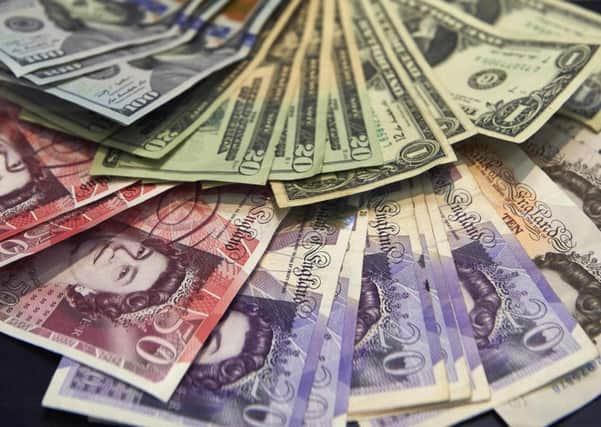Cash savers take a '˜hard Brexit' pounding


The weak pound will continue to benefit investors as a currency recovery becomes increasingly unlikely, but living costs could rise and cash savers face yet more misery. That’s the outlook for the coming months after the UK government’s indication that it would seek a “hard Brexit” sent the pound tumbling to its lowest level for more than three decades. The prospect of an exit from the single market means the currency weakness could now be prolonged, experts say.
The falling pound helped drive the FTSE 100 close to a record high on the day that the pound fell to its lowest level against the US dollar since 1985.
Advertisement
Hide AdAdvertisement
Hide AdIt now seems the pound could be cheap against the dollar and other currencies for some time to come, according to Kathleen Brooks, research director at City Index.
“We think that any recovery is likely to be futile at this juncture with fears of a hard Brexit continuing to build,” she said, pointing to the UK Government’s refusal “to guarantee a special status post-Brexit for the UK’s financial services sector”.
The pound fell mainly because of concerns over the implications of a hard Brexit for the UK’s access to global markets, Bank of England deputy governor Ben Broadbent said this week. The Bank has predicted that UK economic growth will remain sluggish next year and that a weaker pound could push inflation up (due to the cost of importing essentials such as food and clothes).
The impact of long-term currency weakness on everyday finances will depend largely on the response of policymakers.
“The Prime Minister’s indication that a hard Brexit is now on the table is likely to cause firms that were contemplating investing in expanding their activities by investing in a new factory or sales force take a pause for thought,” said Simon Lloyd, chief investment officer at Murray Asset Management in Edinburgh.
“The Bank of England will normally respond to such uncertainty by keeping interest rates low, making the investment decision less challenging for a business.”
That has obvious implications for personal and household finances, not least in terms of savings, investments and the cost of borrowing. While mortgage repayments will remain low for the time being, the impact on savings and investments is mixed.
“One of the reasons the Bank keeps interest rates very low is to make holding cash in the bank less attractive, and certainly deposit rates are very low at present,” said Lloyd.
Advertisement
Hide AdAdvertisement
Hide AdThe interest rates paid on savings accounts have fallen even lower since the Bank of England cut the base rate in August to 0.25 per cent, and the major high street banks have all announced cuts taking effect over the coming weeks.
But the weaker pound could benefit savers and investors if it continues to support the FTSE 100. More than three quarters of revenue generated by companies in the blue chip index is derived from overseas earnings. UK-based firms with international operations benefit both from geographical diversification and the effect of the weaker pound on operational costs.
“So purely as a function of the weak pound, they are looking more profitable and their share prices have responded accordingly,” said Lloyd. “Where a person’s savings are focused here, they will have seen a real lift in recent months; the question is how long the pound’s weakness is likely to last.”
Around 40 per cent of firms in the FTSE 100 declare their dividends in dollars or euros, delivering a boost for income investors. But the longer term outlook for dividends is less rosy. The ten companies with the highest dividends this year may struggle to maintain payouts in future, according to new research by investment platform AJ Bell.
It found that dividend cover (the ratio of profits to dividends) at those firms has fallen to an average of just 1.22, well short of the level of cover that companies are expected to have. The prospect of dividend cuts was previously raised in July, when Capita Asset Services warned that dividend cover had fallen to “very low levels”.
Russ Mould, investment director at AJ Bell, said: “Anything below 1.5 times earnings cover starts to question the sustainability of the dividend should anything go wrong and anything below one means the company is having to dip into cash reserves or borrow or sell off assets to pay their dividend.”